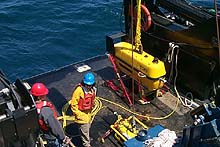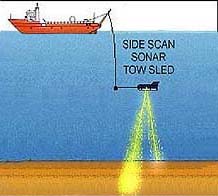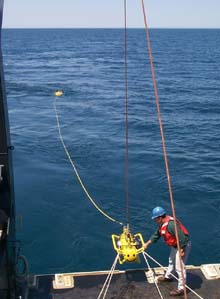
ECHO awaiting deployment aboard the R/V Lake Guardian. It utilizes sound to image objects, as well as geologic features, on the lake. Click image for larger view.
Diagram of a sidescan sonar towfish underwater. The yellow is representative of the “swath” being covered by the sonar beam. Drawing is not drawn to scale. (Institute for Exploration). Click image for larger view.
Deploying ECHO and the depressor weight (embellished with a smiley face). Lines are tied to the depressor to stabilize it during launch. Click image for larger view.
ECHO Technology
ECHO is a sidescan sonar towfish, an instrument that uses sound to create images of the sea floor and objects on it. The acronym "SONAR" stands for "SOund Navigation And Ranging." ECHO is towed close to the sea floor and emits high-pitched “chirps” of sound diagonally through the water. The sound bounces back to ECHO from objects such as rocks or shipwrecks, creating a picture of the sea floor. The resulting images look very much like an object this is being viewed from above, and illuminated from very low and to the side. The sound bounces off only one side, and generates long shadows on the side away from the towfish. The lengths and shapes of the shadows reveal the heights and profiles of the objects.
Because sound waves travel farther than light underwater, they can image large areas of the sea floor more efficiently than lights and video. Sidescan sonar can survey swaths (widths) ranging from about 50 to 1,000 m, depending on the frequency of sound being used. ECHO can use two sound frequencies: 100 and 400 kilohertz. Higher frequencies result in images of better resolution; lower frequencies can “see” farther away from the towfish. The systems complement each other quite well. First, a large area is surveyed with the low- frequency beam. Then, when a target is located, investigators can go back and image the target with a higher-frequency beam to obtain a higher resolution.
The complete ECHO system includes a "depressor," a heavy weight that is attached to the bottom of the main fiber-optic cable. A fixed length of neutrally buoyant cable attaches the ECHO towfish to the depressor. In this configuration, the depressor absorbs undesirable motions of the ship. ECHO is towed along in a straight, undisturbed line to minimize distortions of the acoustic imagery.
Many types of ocean explorers use sidescan sonar. Archaeologists use it to search ancient trade routes for shipwrecks. Geologists search for geologic features, such as sinkholes and ancient submerged coastlines. Pipelines and other man-made structures are surveyed routinely to ensure their structural integrity. Ships and airplanes that crash in the sea are located with sonar. Acousticians are constantly experimenting with various properties of sound, so that they can obtain the best possible images for undersea exploration.
ECHO is the most recent underwater vehicle developed by the Woods Hole Marine Systems Inc., for the Institute For Exploration, with funding from NOAA.
Technical Specifications
Maximum Depth: 3,000 m
ECHO weight in air: 190 kg
Depressor weight in air: 650 kg
Sidescan frequencies: 100 kHz and 400 kHz
Range (100 kHz): approximately 500
Sign up for the Ocean Explorer E-mail Update List.





